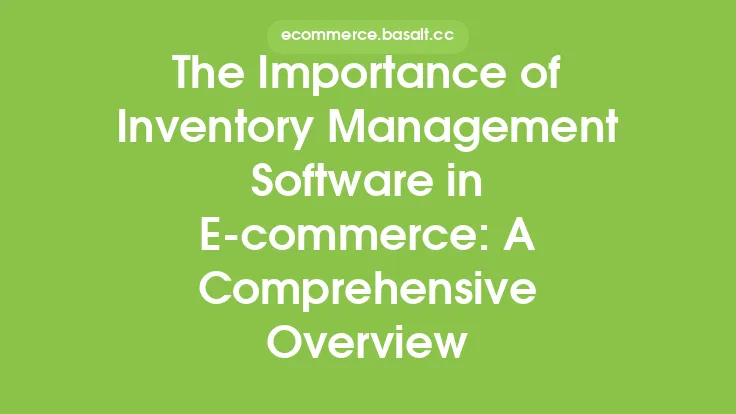Accurate inventory forecasting is a crucial aspect of e-commerce operations, as it enables online retailers to manage their stock levels effectively, reduce costs, and improve customer satisfaction. Inventory forecasting involves predicting the future demand for products, allowing retailers to make informed decisions about inventory levels, pricing, and supply chain management. In this article, we will explore the importance of accurate inventory forecasting for online retailers and provide insights into the benefits and best practices of implementing a robust forecasting system.
Introduction to Inventory Forecasting
Inventory forecasting is a complex process that involves analyzing historical sales data, seasonal trends, and market fluctuations to predict future demand. It requires a deep understanding of the business, its products, and its target market. Online retailers use various methods to forecast inventory, including quantitative and qualitative techniques. Quantitative methods involve using statistical models and algorithms to analyze historical data, while qualitative methods rely on expert judgment and market research. A combination of both approaches can provide a more accurate forecast.
Benefits of Accurate Inventory Forecasting
Accurate inventory forecasting offers numerous benefits to online retailers, including:
- Reduced stockouts and overstocking: By predicting demand accurately, retailers can avoid stockouts and overstocking, which can lead to lost sales and wasted resources.
- Improved cash flow: Accurate forecasting helps retailers to manage their inventory levels effectively, reducing the need for excess inventory and minimizing waste.
- Enhanced customer satisfaction: By ensuring that products are available when customers need them, retailers can improve customer satisfaction and loyalty.
- Better supply chain management: Accurate forecasting enables retailers to negotiate better prices with suppliers, reduce lead times, and improve overall supply chain efficiency.
- Increased competitiveness: Online retailers that can forecast inventory accurately can respond quickly to changes in demand, giving them a competitive edge in the market.
Factors Affecting Inventory Forecasting
Several factors can affect the accuracy of inventory forecasting, including:
- Seasonal fluctuations: Demand for certain products can vary significantly depending on the season, making it essential to account for these fluctuations in the forecasting process.
- Market trends: Changes in market trends, such as shifts in consumer behavior or preferences, can impact demand and affect forecasting accuracy.
- Product life cycles: Products have different life cycles, and demand can vary significantly depending on the stage of the life cycle.
- Weather and external events: Weather conditions, holidays, and other external events can impact demand and affect forecasting accuracy.
- Supplier lead times: The time it takes for suppliers to deliver products can impact forecasting accuracy and inventory levels.
Best Practices for Inventory Forecasting
To implement an effective inventory forecasting system, online retailers should follow these best practices:
- Use historical data: Analyze historical sales data to identify patterns and trends that can inform forecasting decisions.
- Monitor market trends: Stay up-to-date with market trends and changes in consumer behavior to ensure that forecasting is accurate and relevant.
- Use statistical models: Implement statistical models, such as exponential smoothing or regression analysis, to analyze data and make predictions.
- Consider qualitative factors: Take into account qualitative factors, such as expert judgment and market research, to provide a more comprehensive view of demand.
- Review and adjust: Regularly review and adjust forecasting models to ensure that they remain accurate and effective.
Common Inventory Forecasting Methods
Several inventory forecasting methods are commonly used by online retailers, including:
- Moving average: This method involves calculating the average demand for a product over a specific period.
- Exponential smoothing: This method involves weighting recent demand data more heavily than older data to provide a more accurate forecast.
- Regression analysis: This method involves analyzing the relationship between demand and other variables, such as seasonality or market trends.
- Time series analysis: This method involves analyzing historical data to identify patterns and trends that can inform forecasting decisions.
Implementing an Inventory Forecasting System
To implement an effective inventory forecasting system, online retailers should follow these steps:
- Define forecasting goals: Determine what the forecasting system is intended to achieve, such as reducing stockouts or improving cash flow.
- Gather data: Collect historical sales data and other relevant information to inform forecasting decisions.
- Choose a forecasting method: Select a forecasting method that is suitable for the business and its products.
- Implement the system: Implement the forecasting system and integrate it with existing inventory management systems.
- Monitor and adjust: Regularly review and adjust the forecasting system to ensure that it remains accurate and effective.
Conclusion
Accurate inventory forecasting is essential for online retailers, as it enables them to manage their stock levels effectively, reduce costs, and improve customer satisfaction. By understanding the benefits and best practices of inventory forecasting, online retailers can implement a robust forecasting system that informs their inventory management decisions and drives business success. Whether using quantitative or qualitative methods, or a combination of both, accurate inventory forecasting is critical to achieving e-commerce success.




